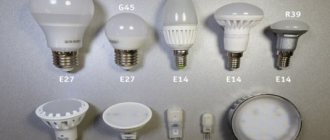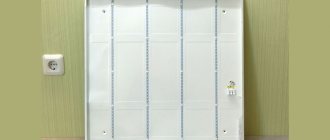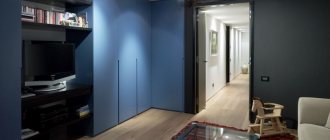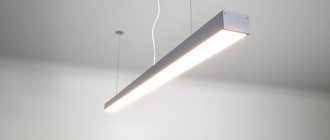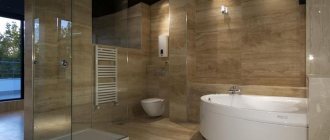How to calculate the number of lamps
Before you think about how to place the lamps on the ceiling, you need to calculate the number of light sources. Basic Rules:
- It is necessary to take into account the presence of reflective surfaces in the room. The more there are, the fewer lamps will be required for lighting.
- Before counting the number of lamps, you need to decide on their type.
- When making calculations, it is important to rely on room illumination standards. Approximate indicators are shown in the table.
Illumination standards
| Room | Indicator, Lux |
| Kitchen, dining room | 150 |
| Children's room | 200 |
| Hall, bathroom, hallway, | 50 |
| Library, office | 300 |
| Wardrobe | 75 |
There are several methods for accurate calculations. Let's talk about the three most popular.
Online calculator
You can find special calculators on the websites ledeffect.ru, potolki-podvesnie.ru, calc.ru, where the necessary formulas for calculations are already integrated. To get the result, just enter individual data in the form fields. Calculations may vary depending on the type of calculator, so experts consider this method not entirely objective.
The photo shows the Ledeffect online calculator. For calculations using other services, similar data will be required.
An example of a calculator for calculating the number of lamps
Formula
There are several formulas that can be used to determine the number of lamps per room. We suggest using the simplest and most understandable one.
First you need to calculate the brightness of the study, which is measured in lumens. To do this, you can use the formula: X=A*B*C.
Let's understand the notation:
- A is the standard illumination for a specific room.
- B is the area of the room in square meters.
- C is the ceiling height coefficient.
Coefficients for ceilings of different heights
| Height, m | Indicator for formula |
| up to 2.7 | 1 |
| 2,7-3,5 | 1,5 |
| 3.5 and above | 2 |
After calculating the optimal brightness, you can begin to calculate the number of lamps. To do this, the resulting indicator must be divided by the power of one lamp of the selected type. The parameters of different light sources are presented in the photo.
Power of different types of lamps
Special programs and applications for lighting calculations
Unlike online calculators, such programs allow you to get accurate indicators. This is an excellent opportunity to include in the study not only the area of the room and lighting standards, but also the architectural features of the premises. Using the program, you can also determine how best to position the lamps on the ceiling. Application examples: Dialux, Ulysse, Europic.
Lighting with ceiling lamps
How to calculate the distance between lamps
The distance between lamps is primarily affected by the layout of the elements. However, regardless of it, the optimal distance is 30-40 cm. If the lamps are bright, the distance can be reduced to 20 cm.
If the room provides additional lighting through sconces, floor lamps and table lamps, the number of ceiling lights can be reduced. Accordingly, the distance between them will be greater.
And again we remind you of the importance of reflective elements in the interior. If there are mirrors and glossy surfaces in the room, the streams of light will be evenly scattered throughout the room. In this case, the distance between the lamps can be increased.
An example of the arrangement of lamps at a large distance from each other
An example of placing lamps close to each other
Advice! When calculating the distance between lamps, it is important to take into account the type of ceiling structure. The tension fabric may not withstand excessive load, so you should not “partially” with the elements.
How to install a lamp in suspended ceilings mounted on a profile
The lamp mounted on a profile is widely used for furnishing office premises. Fluorescent lamps are used as a light source for such structures. However, this design can be used to decorate a living room or bedroom.
If you want to choose a device that will not create sharp shadows or glare, give preference to raster lamps equipped with a biparabolic grille.
Installation of this design is carried out in the following order:
Features of lamps for suspended ceilings
Stretch ceilings are considered the most attractive and aesthetic finishing solution. An important point is that you need to think through lighting options in advance in order to install the lamps at the same time as the canvas. PVC film also begins to melt at a temperature of 60-70°C, so only certain types of lamps are suitable.
You also need to immediately decide on the design of the lamps and the type of their attachment to the surface. Let's look at the available instrument options.
Spotlights
Point devices are products whose body is completely built into the ceiling structure or protrudes slightly beyond it. They are suitable both as sources of general lighting and for backlighting. With the help of spotlights, you can implement various lighting scenarios and transform the interior of a room.
The method of installation of devices will depend on their type. Built-in models are fixed in the ceiling thanks to a special spring mechanism. Adjustable stands are used to place overhead lamps. The body of the product is fixed using special thermal rings.
Spotlights in the interior
Pendant lamps and chandeliers
Compact chandeliers and lamps in shades are also suitable for installation on suspended ceilings. It is better to give preference to models with downward-facing lamps. This design of the products will eliminate overheating of the ceiling materials and the appearance of glare.
Important! The main task during installation is to ensure that the device body is located at a distance of at least 10 cm from the ceiling surface.
To be able to place pendant lights and chandeliers, a durable hook must be integrated into the base ceiling before installing the tension fabric. It is needed to attach a chain or cable that holds the frame of the lamps. Don't worry that the design will be noticeable - it will disappear behind the canvas. Only the chandelier itself and a fragment of the fixing cable will appear to the eye.
Chandelier in the interior of the room
Pendant lamps in the interior of the room
Raster lamps
Raster lamps are compositions of fluorescent lamps enclosed in reflective structures. This is an ideal choice for spacious rooms that require bright lighting. However, the products will not please you with an impressive design - they look as laconic as possible.
Installing such lamps is easy. It is enough to provide several holes of suitable dimensions in the tension fabric.
Raster lamps in the interior of the room
Track lights
Track lights are light elements located on the busbar. The lamps can be moved and rotated to a convenient position. Such products are indispensable for creating accent lighting and lighting compact rooms.
To fix the track lights to the tension fabric, special built-in elements are used - it is on them that the busbar will be attached. This design is completely safe for ceiling materials.
Track lamps in the interior of the room
LED lights
For additional lighting, you can use a monochrome or color LED strip. With its help it is easy to create various patterns and light patterns on a stretch ceiling.
The main advantage of the tape is that it does not generate heat. It can be safely mounted directly on the tension fabric.
LED ceiling light
Installation of modular luminaires
To begin with, it will be useful to understand the structure of modular lamps. This will make it easier to understand the installation process, help you install it correctly and, most importantly, connect the devices to power.
The classic modular lamp for Armstrong ceilings consists of the following main components:
- frame;
- reflective grille;
- fluorescent lamps;
- starting devices;
- terminals for connecting power.
For power supply, a terminal block is provided in the housing.
N, L and PE – zero, phase and ground, respectively. The housing has dimensions of 600×600 mm, thanks to which it easily fits into the cell of the suspended ceiling frame. The reflective grille is designed to protect lamps from mechanical damage and to redirect the light flux into the room.
Fluorescent lamps are light sources, usually with a power of 18 W each. For their correct ignition, the lamps are equipped with starting devices with replaceable capacitors (two for each lamp).
Recessed luminaire Lumsvet LVO 4x18 Milano
Size: 600x600 mm Number of lamps: 4 Base: G 13
Recessed luminaire Lumsvet LVO 4x18 Opal
Size: 600x600 mm Number of lamps: 4 Base: G 13
LED lamp Varton Downlight 145x145x42 13w
Size: 145x145x42.5 mm Luminous flux (lm): 1000 Color temperature (K): 4000
LED lamp Varton recessed 595x595x50 25w
Size: 595x595x50 mm Luminous flux (lm): 2500 Color temperature (K): 4000
How to place lamps on the ceiling: diagrams
Regardless of the number and type of devices, it is important to follow the basic rules for the location of lamps. The minimum distance from the light point to the edge of the ceiling should be at least 20 cm. If the structure is tensioned, an indentation should also be made from the seams - at least 15 cm.
We offer several popular lighting layouts. You will find interesting options for different numbers of lamps.
With chandelier
In such a scheme, the chandelier becomes the main accent. Additional sources include overhead or spotlights.
The position of the chandelier is simple - it is better to place it in the center of the ceiling. But the layout for the placement of spots should be chosen depending on the purpose of the room and its dimensions. The photo shows common combinations with different numbers of lamps.
Examples of placement of lamps in the presence of a chandelier
For small rooms, corner placement of spots is preferable. The lighting will be moderately bright and uniform.
If the room is square, it is better to place lamps around the chandelier. Thanks to this technique, the illuminated room will seem much more spacious.
For rectangular rooms, an oval or arc-shaped arrangement of additional elements is suitable. If the room is very spacious, you can add lamps in the corners.
With pendant lights
If you don’t know how to place lamps on a suspended ceiling, you can use diagrams for lighting design with a chandelier. However, if there is more than one pendant lamp, you will have to vary the number of additional elements. Examples of location are shown in the photo.
Examples of placement of spotlights and pendant lamps
Without chandelier
If there is no chandelier in the interior, you can organize the main lighting using spots. We need to decide how to place the elements. There are no strict rules - designers actively experiment with schemes, observing basic requirements.
If you need a ready-made solution for how to arrange 6, 8 or more lamps, consider the optimal design options.
Examples of placement of ceiling lights without a chandelier
Advice! If there are a lot of lamps, it is better to “split” them into groups and distribute them by zones or brightness.
In this case, you can change the light level in a certain part of the room.



